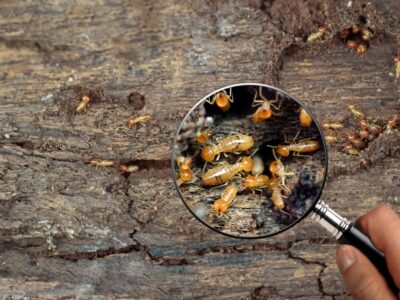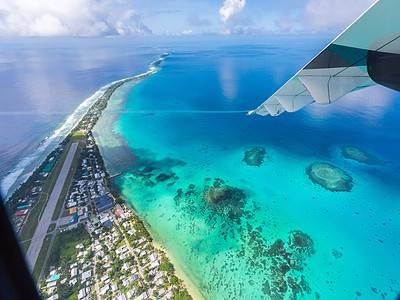Frigatebird
Fregata
Found inhabiting tropical islands and coasts!
Advertisement
Frigatebird Scientific Classification
- Kingdom
- Animalia
- Phylum
- Chordata
- Class
- Aves
- Order
- Pelecaniformes
- Family
- Fregatidae
- Genus
- Fregata
- Scientific Name
- Fregata
Read our Complete Guide to Classification of Animals.
Frigatebird Conservation Status
Frigatebird Facts
- Lifestyle
- Colony
- Favorite Food
- Fish
- Type
- Bird
- Average Clutch Size
- 1
- Slogan
- Found inhabiting tropical islands and coasts!
View all of the Frigatebird images!
“The frigatebird is the bird with the largest wingspan in comparison to their body size.”
There are five different species of frigatebirds that can be found near tropical and subtropical coasts around the world. These birds can fly for hours, days, or even weeks at time due to their large wingspan. They have a slender black body and wings. and the males have a very unique red pouch that inflates when they are trying to attract a mate.
5 Incredible Frigatebird Facts
• Frigatebirds are also known as man-o’-war birds.
• Compared to their body size, this bird’s wingspan is larger than that of any other bird.
• Females can spend up to one-and-a-half years rearing their chick before it will be ready to go out on its own.
• These birds often steal fish and other food from other seabirds using their hooked beak.
• On land, frigatebirds live in a large colony with up to 5,000 other birds.
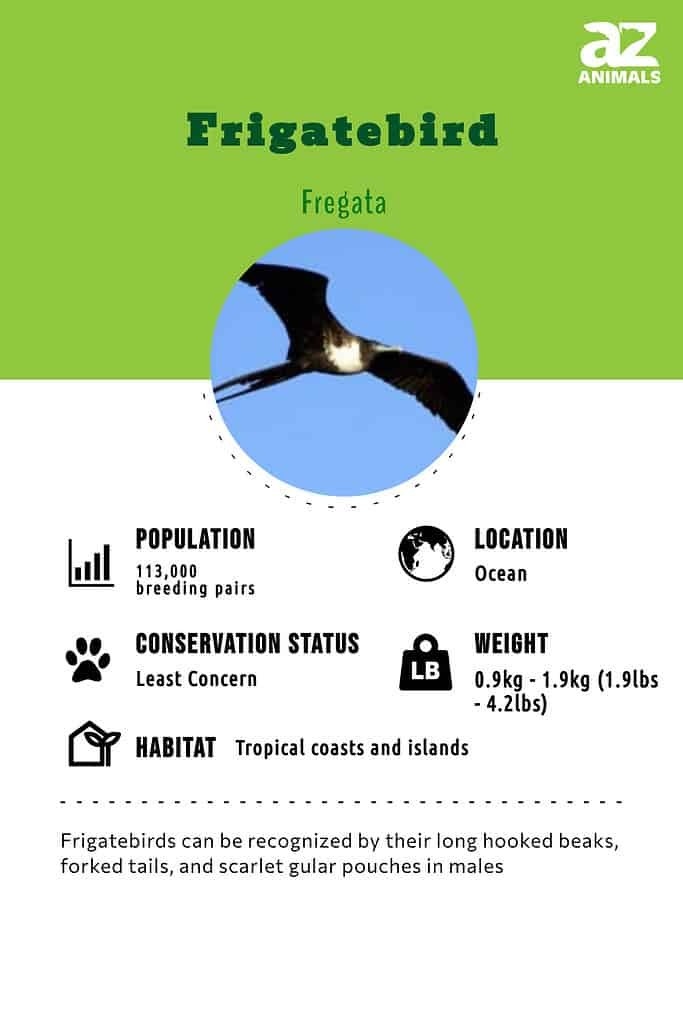
Scientific name
The frigatebird’s scientific name is Fregata. Sometimes spelled Frigate, this is a suborder of the Pelecaniformes family, known as Fregatidae. Fregatidae is the family that all of these birds belong to. They are defined as being seabirds with webbed feet.
There are five different subspecies, which include:
- the great frigatebird (Fregata Minor)
- the Christmas frigatebird (Fregata Andrewsi)
- the magnificent frigatebird (Fregata Magnificens)
- the Ascension Frigatebird (Fregata Aquila)
- the lesser frigatebird (Fregata Ariel)
Appearance and Behavior

Frigatebirds are fond of pilfering food from other birds
©Aviceda at English Wikipedia / CC BY 3.0, Wikimedia Commons – License
These birds are mostly black in color, and they have a hooked bill, which is used to catch and/or steal fish from other birds. They also have very small webbed feet. During their courting season, males can be easily identified by their bright red inflated pouch on their throats, known as a gular pouch. This area of their body becomes as large as a person’s head when they are trying to attract females. Adult females have white markings on their undersides.
Four of the five species (magnificent frigatebirds, Christmas frigatebirds, Ascension frigatebirds, and great frigatebirds) are all relatively similar in size. They have a short neck with a very slender body. The magnificent frigatebird is about 45 inches long, and the other three subspecies are nearly as large. The lesser frigatebird is significantly smaller than its counterparts and is only around 28 inches long.
These birds have very distinct wings. They are narrow and taper down to a point on either side. Additionally, these birds are known for their very long wingspan. A male’s wingspan can be over two meters long. This is as tall as Michael Jordan. In fact, when compared to their body size, this bird’s wingspan is larger than that of any other bird.
The face and legs are covered in black feathers. They have 11 primary flight feathers on their wings and 23 secondary feathers.
Due to their wingspan and small body, a frigatebird is very aerial. They are able to soar for very long periods of time without needing to flap their wings. Because of this, these birds spend a lot of time flying and may stay airborne for days or even weeks, only returning to land when it is time to roost.
These birds are unable to swim, unlike some other birds. They also have very short legs, which prevents them from being able to take flight from the water and makes it challenging for them to walk on land.
Evolution and Classification

Cormorants are members of the clade Aequornithes, making them and other members relatives of frigatebirds
©iStock.com/BrianLasenby
As members of the clade (a group of living organisms which share a common ancestor) Aequornithes, Frigatebirds are also cousins of the following birds:
- Anhingidae: Aquatic birds which live in the tropics, these birds are also referred to as snakebirds owing to their long necks. They include African darters, American darters, Australasian darters, and Indian darters.
- Phalacrocoracidae: Dark plumage, slender beaks, and webbed feet, are the main distinguishing features of members of this family. They include crowned cormorants, Indian cormorants, Japanese cormorants, little cormorants, Pitt shags, and rock shags.
- Sulidae: Effective streamlined forms, webbed feet, and sturdy legs are the key features of these seabirds which measure between 2 to 3 feet in length.
Their beaks are also noticeable with a slight downward curve. Sulids include Abott’s boobies, Blue-footed boobies, Cape gannets, and Northern gannets.
The tale of frigatebirds goes all the way back to the Eocene, about 34 – 56 million years ago. Three species of frigatebird lived during the early part of this epoch including Limnofregata azygosternon, Limnofregata hasegawai, and Limnofregata hutchisoni. They were pretty similar to frigatebirds in their current form although their legs were longer and their beaks shorter.
Types
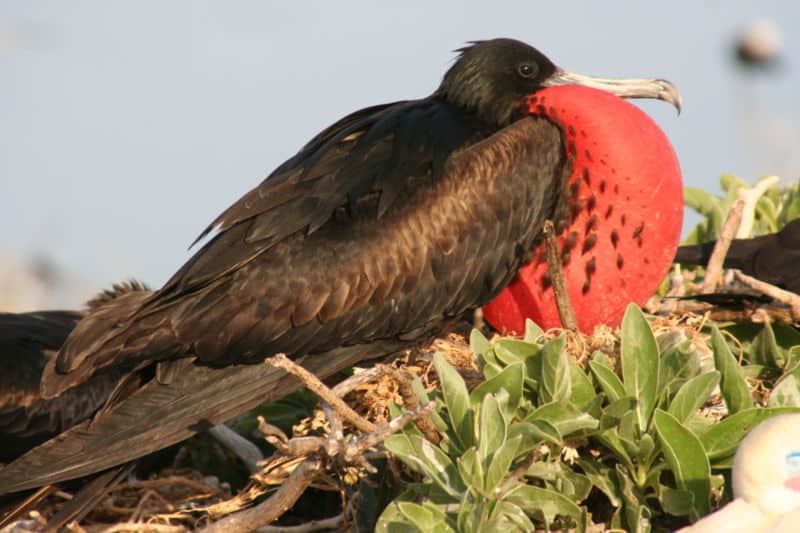
Great frigatebirds practise kleptoparasiticm to a lesser degree than other species
©Duncan Wright – Public Domain
- Ascension frigatebird (Fregata aquila): This bird’s distinguishing features include a blue-gray beak, dark plumage, and a scarlet gular sac in males to attract females. It can be found on Ascension and Boatswain Bird Islands in the Atlantic.
- Christmas frigatebird (Fregata andrewsi): This resident of Christmas Island in the Indian Ocean, can be recognized by its dark plumage, a white oval patch on its stomach, and a vivid red gulag sac.
- Great frigatebird (Fregata minor): Members of this subspecies are covered in plumage which is black for the most part. For some reason, they are less prone to divesting other birds of their sustenance.
- Lesser frigatebird (Fregata ariel): With a length of 21/2 feet, lesser frigatebirds are the smallest members of this rather compact unit. Their plumage is black-brown although females have white chest feathers.
- Magnificent frigatebird (Fregata magnificens): The largest species of the bunch, members may measure 3 feet – 3 feet 9 inches in length. They are covered in black-brown feathers and exhibit the same penchant for snatching other bird’s meals from them, as other members of their family.
Habitat
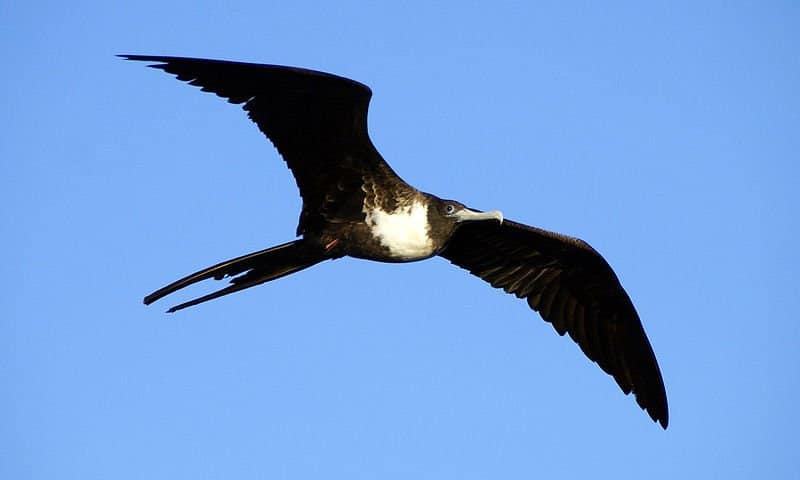
Frigatebirds live near tropical and semi-tropical coasts all around the world.
Frigatebirds live near tropical and semi-tropical coasts all around the world. In most cases, they stay within a 100-mile range of land so they can easily return to breed and nest. The exact range and location of these birds can vary based on where they are able to find food. Since they fly with the updrafts beneath cumulus clouds, the trade winds can also influence where they may fly.
The magnificent frigatebird can be found in different areas along the tropical portions of the Atlantic Ocean, such as Florida and the Caribbean. These birds can also be found along the Pacific Ocean off the coast of Central and South America between Mexico and Ecuador. They also live along the Galapagos Islands.
Great frigatebirds are also found in different tropical areas around the globe. These birds live along the Pacific Ocean as far north as Hawaii. They can also be found near Wake Island, New Caledonia, and the Galapagos in the Central and South Pacific. Additionally, you can also find the great frigatebird in the Indian Ocean near Christmas Island, the Maldives, Mauritius, and Aldabra.
Christmas frigatebirds live near Christmas Island, Australia, which is located in the Indian Ocean.
Ascension frigatebirds live near Boatswain Bird Island, which is located in the South Atlantic Ocean off the coast of Ascension Island.
The lesser frigatebird lives over the seas around Australia. These birds can often be found near some of the more remote islands, like Christmas Island, where they like to breed.
Population
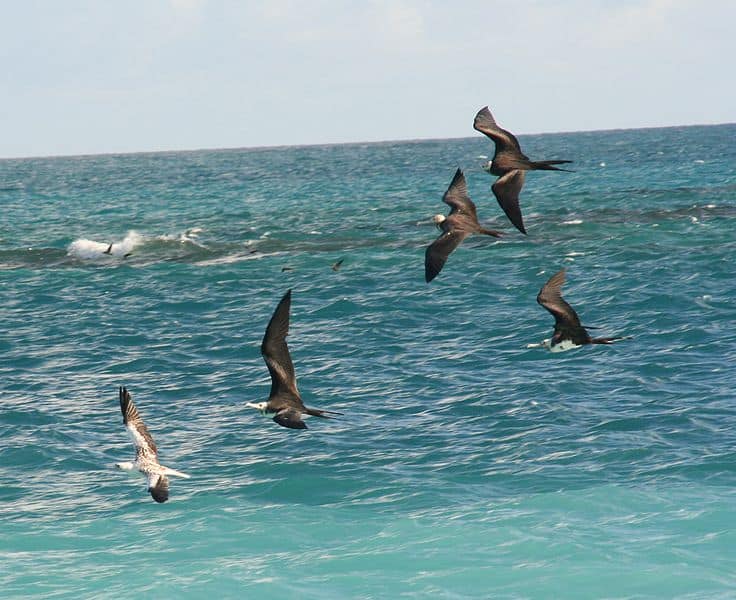
The overall population of frigatebirds numbers in the hundreds of thousands
©Duncan Wright – Public Domain
It is challenging for scientists to monitor the population of these birds since they move around often and don’t reproduce as much as some other species. It is estimated that there are between 59,000 and 71,000 breeding pairs of magnificent frigatebirds worldwide, putting their conservation status is least concern. The number of these creatures worldwide is currently increasing.
Scientists believe there are between 3,600 and 7,200 Christmas frigatebirds, deeming them critically endangered.
There are likely several hundred thousand lesser frigatebirds, though their population is decreasing as well with a conservation status of least concern.
It is estimated that there are only about 12,500 Ascension frigatebirds left in the world. They have a conservation status of vulnerable.
The great frigatebird has a conservation status of least concern. There are still a lot of these birds located throughout the world.
Diet

Frigatebirds catch their food in flight, hence flying fish are one of their favorite foods
©iStock.com/neil bowman
These birds will use their hooked bills to grab prey from the ocean. Unlike other birds, they do not land on the water to catch food. Flying fish is one of the main foods these birds prefer. They also enjoy cephalopods, like squid, jellyfish, menhaden, large plankton, and even hatchling turtles. Oftentimes, they will follow fishing boats and snatch fish from the boat. They are also known for stealing fish from other seabirds.
In addition to catching fish and other sea creatures, these birds sometimes eat the eggs or chicks from other seabird species, some of which include shearwaters, terns, petrels, and jellyfish and boobies.
Predators and Threats
Frigatebirds do not have too many natural predators since they are a larger bird and spend most of their time airborne. However, there are a few predators that threaten them when they are on land. Stoats, domestic cats, and rats may hunt for these birds or eat their eggs.
Humans pose the greatest threat to this bird. Many of the fish they eat are being overfished, which decreases the amount of food that is available to them, putting more frigatebirds at risk of dying. Many also nest in dense colonies, which could mean a large portion of their population could be wiped out in the event of a local or natural disaster.
Each of the five subspecies faces different threats based on where they live. For example, the Christmas Island frigatebird suffered when much of its breeding habitat was cleared during World War II. These birds were also exposed to dust pollution from phosphate mining, which has led to decreased numbers. Due to these threats and habitat changes, the Christmas Island frigatebird’s conservation status is critically endangered.
The Ascension frigatebird once bred and nested on Ascension Island. However, in 1815, feral cats were introduced to the island and wiped out the population. This left a smaller number of Ascension frigatebirds that were able to breed offshore on a rocky outcrop. Between 2002 and 2004, the feral cats were eradicated from Ascension Island, and some Ascension frigatebirds have begun nesting there once again. However, the damage deems Ascension frigatebirds vulnerable.
While the other three subspecies — the great frigatebird, the magnificent frigatebird, and the lesser frigatebirds — still face threats, their population numbers are not as worrisome. These three subspecies share a conservation status of least concern.
Reproduction, Babies, and Lifespan
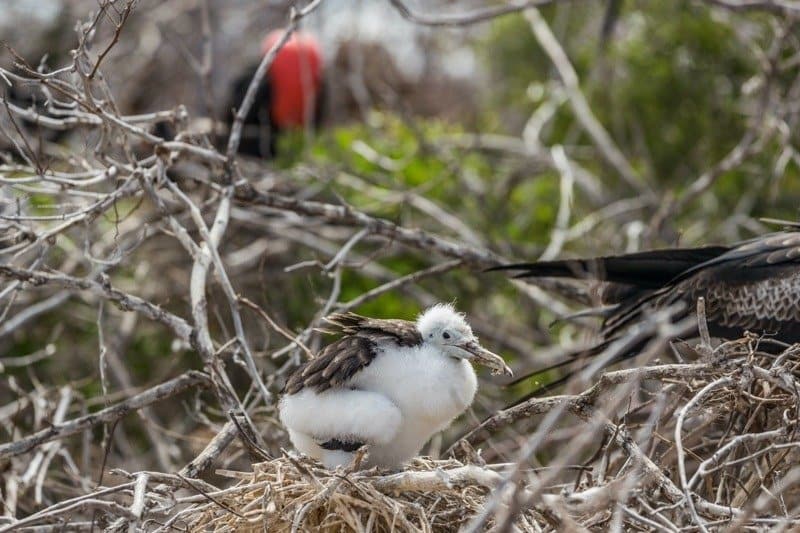
Frigatebird chicks are cared for by both parents during the first three months of their lives
©Maridav/Shutterstock.com
Frigatebirds choose to breed on more remote islands. They typically live in larger colonies made up of as many as 5,000 birds, though their nesting groups are smaller, typically between 10 or 30 and possibly up to 100. There is no specific mating season for frigatebirds; they may breed at anytime throughout the year, often choosing to breed when the dryer season starts and food is less easy to find.
Frigatebirds do not mate for life. However, they do stay with the same mate for an entire breeding season. To attract a mate, male birds will begin residing in one of the colonies. They perform a mating display to attract a female. They inflate their large red gular pouch, vibrate their wings, and point their bills up. During this display, a male also vibrates its bill to make a drumming sound for the females. When a female chooses a male, she will fly to him and let him put her bill inside of his. The two birds will then begin “head-snaking.”
The male will gather sticks and the female will uses these sticks to create a woven nest after the birds have copulated. Guano is then added on top of the nest for added stability. Typically, these birds make their nests in bushes or trees, but they sometimes nest on the ground if no trees or bushes are available.
Female frigatebirds lay one white egg, which typically weighs between 6% and 7% of the weight of the mother. Incubation takes between 41 and 55 days, and both the male and female frigatebirds take turns keeping the egg warm.
When chicks hatch from their eggs, they have no feathers. After about two weeks, they begin to develop a white down covering. The male and female share the responsibility of keeping a continuous eye on their chick for the first four to six weeks. They also both feed their chick for the first three months or so. After this time, the male leaves the colony and the female must continue caring for the chick on her own. The chicks stay in their nests for the first five or six months of their lives.
Adult frigatebirds feed their chicks by offering them regurgitated food. The parents open their mouths so the chicks can reach into their throats to get the food. Initially, the chicks will need to eat multiple times a day, but after a while they will only need to be fed once every day or even every other day.
Rearing a frigatebird chick can take between 9 and 12 months. This is longer than most other species of birds, with the exception of the southern ground hornbill and some accipitrids. Because of how long it takes to care for a chick, frigatebirds typically breed every other year instead of every year.
The chicks take their first flight somewhere between the age of 20 and 24 weeks. Frigatebirds take longer to reach the age of sexual maturity than other birds. For females, this is typically between the ages of 8 and 9 years old, and for males it is between the ages of 10 and 11 years old.
Frigatebirds have a long lifespan compared to many other species of birds. The magnificent frigatebird’s lifespan is around 34 years, the great frigatebird’s lifespan is between 30 and 34 years, the Christmas frigatebird’s lifespan is about 25 years, and the lesser frigatebird’s lifespan is between 17 and 23 years.
In the Zoo
There are very few zoos and aquariums offering an up-close look at this amazing animal. Two places where you can are the Texas State Aquarium and Sea Life Park in Hawaii.
View all 91 animals that start with FFrigatebird FAQs (Frequently Asked Questions)
Are frigatebirds carnivores, herbivores, or omnivores?
Frigatebirds are carnivores. They eat fish, squid, turtles, eggs, and even other seabird chicks.
What is the red pouch on a frigatebird?
The bright red pouch on a frigatebird is called a gular pouch. Only males have this pouch, and it inflates when they are trying to attract a female mate.
What do frigatebirds eat?
Frigatebirds enjoy flying fish. They also eat squid, large plankton, jellyfish, hatchling sea turtles, and the eggs and chicks of other seabirds.
Why are they called frigatebirds?
The word frigatebird comes from La Frégate, a French word that means a fast warship. French mariners who saw the frigatebirds gave them this nickname because of their resemblance to a man-of-war. Like the man-of-war, the frigatebirds could soar for long periods of time and (the males) have a red neck.
What is the wingspan of the frigatebird?
A frigatebird can have a wingspan that is two or more meters long.
What is the magnificent frigatebird?
The magnificent frigatebird is one of the subspecies of frigatebirds. It is the largest species of this animal. Magnificent frigatebirds can be found over subtropical and tropical waters between Peru and Mexico, on the Pacific coast between Brazil and Florida, in the Cape Verde Islands, and in the Galápagos Islands.
Do frigatebirds mate for life?
No, frigatebirds do not mate for life. However, they do stay with the same mate during each breeding season.
Do frigatebirds sleep while flying?
Frigatebirds do sleep some when flying, but not very much. They only sleep for less than 3% of the time they are flying, and only at night. When they are on land, however, a frigatebird may sleep for 12 hours or more.
What Kingdom do Frigatebirds belong to?
Frigatebirds belong to the Kingdom Animalia.
What class do Frigatebirds belong to?
Frigatebirds belong to the class Aves.
What phylum to Frigatebirds belong to?
Frigatebirds belong to the phylum Chordata.
What family do Frigatebirds belong to?
Frigatebirds belong to the family Fregatidae.
What order do Frigatebirds belong to?
Frigatebirds belong to the order Pelecaniformes.
What genus do Frigatebirds belong to?
Frigatebirds belong to the genus Fregata.
What type of covering do Frigatebirds have?
Frigatebirds are covered in Feathers.
In what type of habitat do Frigatebirds live?
Frigatebirds live on tropical coasts and islands.
What are some predators of Frigatebirds?
Predators of Frigatebirds include humans, rats, and cats.
What are some distinguishing features of Frigatebirds?
Frigatebirds have large wingspans, and males have enlarged red throats.
How many eggs do Frigatebirds lay?
Frigatebirds typically lay 1 egg.
What is an interesting fact about Frigatebirds?
Frigatebirds are found to inhabit tropical islands and coasts!
What is the scientific name for the Frigatebird?
The scientific name for the Frigatebird is Fregata.
What is the lifespan of a Frigatebird?
Frigatebirds can live for 15 to 25 years.
Thank you for reading! Have some feedback for us? Contact the AZ Animals editorial team.
Sources
- Britannica, Available here: https://www.britannica.com/animal/frigate-bird
- Audubon, Available here: https://www.audubon.org/field-guide/bird/magnificent-frigatebird
- Edge of Existence, Available here: http://www.edgeofexistence.org/species/christmas-frigatebird/#:~:text=Habitat%20and%20Ecology,including%20seabird%20eggs%20and%20chicks.
- Blue Bulb Projects, Available here: https://www.bluebulbprojects.com/MeasureOfThings/results.php?amt=2&comp=length&unit=m&searchTerm=2+meters
- World Life Expectancy, Available here: https://www.worldlifeexpectancy.com/bird-life-expectancy-great-frigatebird
- Tree Hugger, Available here: https://www.treehugger.com/new-study-proves-birds-can-sleep-while-flying-4858587










